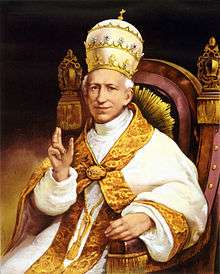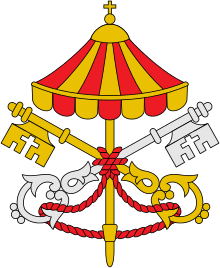Papal conclave, 1878
| Papal conclave February 1878 | |
|---|---|
|
Coat of arms during the vacancy of the Holy See | |
| Dates and location | |
|
18–20 February 1878 Sistine Chapel, Apostolic Palace, Rome | |
| Key officials | |
| Dean | Luigi Amat di San Filippo e Sorso |
| Sub-Dean | Camillo di Pietro |
| Camerlengo | Gioacchino Pecci |
| Protopriest | Josef Friedrich von Schwarzenberg |
| Protodeacon | Prospero Caterini |
| Election | |
| Ballots | 3 |
| Elected Pope | |
|
Vincenzo Gioacchino Raffaele Luigi Pecci (Name taken: Leo XIII) | |
 | |
The Papal conclave of 1878 resulted from the death of Pope Pius IX in the Apostolic Palace in the Vatican on 7 February 1878. The conclave occurred in circumstances different from those of any previous conclave.
Unique circumstances
The unique circumstances were
- the longest reign of any other pope since Saint Peter, meaning that Pius IX had had a greater opportunity than any other pope in history to shape the College of Cardinals by selecting people who shared his worldview and religious vision.
- the first conclave in which the person selected would reign as pope but not as sovereign of the Papal States, the latter having been swept away by the unification of Kingdom of Italy in 1870.
- a change of venue, as the previous venue used in most papal conclaves in the 19th century, the former papal residence, the Quirinal Palace, was no longer in papal ownership and was now the palace of Umberto I, King of Italy.
Questions facing the cardinals
When the cardinals assembled, they faced a dilemma. Should they choose a pope who would continue to espouse Pius IX's reactionary religious and political views, and would continue to refuse to accept Italy's Law of Guarantees guaranteeing the pope religious liberty in the Kingdom of Italy? Or should they turn away from the policies of Pius IX and choose a more liberal pope who could work for reconciliation with the King of Italy? Would choosing such a policy be seen as a betrayal of Pius IX, the self-proclaimed "Prisoner in the Vatican"?
Other broader issues included
- Church-state relations in Italy, the Third French Republic, Ireland and the United States
- the heresy Pope Leo XIII later called Americanism
- divisions in the Church caused by the proclamation of Papal Infallibility by the First Vatican Council
- the status of the First Vatican Council, which had been halted after the Italian 'liberation' of Rome but never wound up.
Though not explicitly spelt out, another issue was raised by the length of Pope Pius' reign. Should they elect another young pope who might reign for decades, or should they go for an older man and so a shorter reign?
Conclave
With what many Churchmen believed was the "unstable" and "anti-Catholic" situation in a Rome that was no longer controlled by the Church, some cardinals, notably Cardinal Manning, Archbishop of Westminster, urged that the conclave be moved outside Rome, perhaps even to Malta.[1] However the Camerlengo, Gioachino Pecci, advocated otherwise, and an initial vote among cardinals to move to Spain was overturned in a later vote. The conclave finally assembled in the Sistine Chapel in the Vatican on 18 February 1878.
Going into the conclave, Cardinal Pecci was the one candidate favored to be elected in part because many of the cardinals who headed to Rome had already decided to elect him.[2] In addition to Pecci's competent administration as Camerlengo during the sede vacante period up to the conclave, Pecci was seen as the opposite of Pope Pius IX in terms of manner and temperament and also had a successful diplomatic career prior to being Archbishop of Perugia.[2] Pecci's election was also facilitated in that the candidate favored by the conservatives Alessandro Franchi urged his supporters to switch their support to the Camerlengo.[2]
Unusually for conclaves, the voting patterns became public.
Ballot 1 (morning 19 Feb)
On the first ballot, held on the morning of the 19 February the votes were
- Gioacchino Pecci 19 votes
- Luigi Bilio 6 votes
- Alessandro Franchi 4 votes
Ballot 2 (afternoon 19 Feb)
- Pecci 26
- Bilio 7
- Franchi 2
Ballot 3 (morning 20 February)
- Pecci 44 – elected
Result, implications, and aftermath
The election of Cardinal Pecci, who took the regnal name of Pope Leo XIII, was a victory for the liberals. Pecci had been an effective bishop whose diocese had moved from the Papal States to the Kingdom of Italy successfully, without Church problems. He was seen as a diplomatic pragmatist with the tact and flexibility opponents of the previous pope believed Pius IX lacked. At 68 Leo was also young enough to do the job without hindrance of health problems, but old enough to offer the prospect of a relatively short reign of ten to fifteen years. Whereas Pius IX was seen as having isolated the Church from international opinion (his locking of Jews into ghettos and treatment of minorities had been condemned by world leaders such as William Ewart Gladstone), Leo was seen as an "internationalist" who could earn back the Vatican some international respect.
Pope Leo came to be seen as embodying a dramatic difference to the papacy of Pope Pius. In one area however they were similar. Though always seemingly in poor health and delicate condition, he reigned for an unexpected 25 years, becoming the third longest-reigning pope in history (until his record was surpassed by Pope John Paul II on 14 March 2004). Far from being a short reigned pope, Leo surprised all by living to the age of 93, dying 20 July 1903, making him the oldest Pope at the time of his passing.
Conclave factfile

- Dates: 18–20 February 1878
- Location: Sistine Chapel in the Vatican
- Arrived late: 2 cardinals
- Paul Cullen, Archbishop of Dublin (Primate of Ireland)
- John McCloskey, Archbishop of New York (United States)
- Unavailable through ill-health:
- Godefroy Brossais-Saint-Marc, Archbishop of Rennes (France)
- Present included : (candidates in bold italics)
- Luigi Amat di San Filippo e Sorso Dean of the College of Cardinals
- Luigi Bilio, Bishop of Sabina
- Friedrich Johannes Jacob Celestin von Schwarzenberg, Prince-Archbishop of Prague (Bohemia, part of Austria-Hungary)
- Gioacchino Vincenzo Raffaele Luigi Pecci, Camerlengo (Papal Chamberlain), Bishop of Perugia (Italy)
- Lucien-Louis-Joseph-Napoleon Bonaparte
- Alessandro Franchi
- René-François Régnier, Archbishop of Cambrai (France)
- Joseph-Hippolyte Guibert, Archbishop of Paris (France)
- Mieczysław Halka Ledóchowski, Archbishop of Gnesen and Posen, (Poland, part of the Russian Empire).
- Henry Edward Manning, Archbishop of Westminster (Head of the Catholic Church in England and Wales).
- Victor-Auguste-Isidor Deschamps, Archbishop of Mechelen (Belgium).
- Johann Rudolf Kutschker, Archbishop of Vienna, Austria-Hungary
- Prospero Caterini, Protodeacon, Secretary of the Inquisition. <ref name=Caterini /[3]
- Teodolfo Mertel<ref name=Mertel /[4]
| LENGTH OF CONCLAVE | 2 days |
|---|---|
| NUMBER OF BALLOTS | 3 |
| ELECTORS | 64 |
| Absent | 3 |
| Present | 61 |
| Africa | 0 |
| Latin America | 0 |
| North America | 0 |
| Asia | 0 |
| Europe | 61 |
| Oceania | 0 |
| Mid-East | 0 |
| Italians | 40 |
| VETO USED? | No |
| DECEASED POPE | PIUS IX (1846–1878) |
| NEW POPE | LEO XIII (1878–1903) |
Trivia
Given that the 1878 conclave was preceded by the longest papal reign in history and ushered in the third longest reign in history, it is worth noting the four participating cardinals for whom this was not the only conclave in which they participated:
Also participated in 1846 conclave
- Luigi Amat di San Filippo e Sorso
- Fabio Maria Asquini
- Domenico Carafa della Spina di Traetto
Also participated in 1903 conclave
References
- ↑ Hittinger, Russell. "Pope Leo XIII", The Teachings of Modern Christianity on Law, Politics, and Human Nature, (John Witte and Frank S. Alexander, eds.), Columbia University Press, 2006 ISBN 9780231133586
- 1 2 3 Valérie Pirie. "The Triple Crown: An Account of the Papal Conclaves - Concluding Chapter: Leo XIII and His Successors".
- ↑ "Caterini, Prospero". Cardinals of the Holy Roman Church.
- ↑ "Mertel, Teodolfo". Cardinals of the Holy Roman Church.
